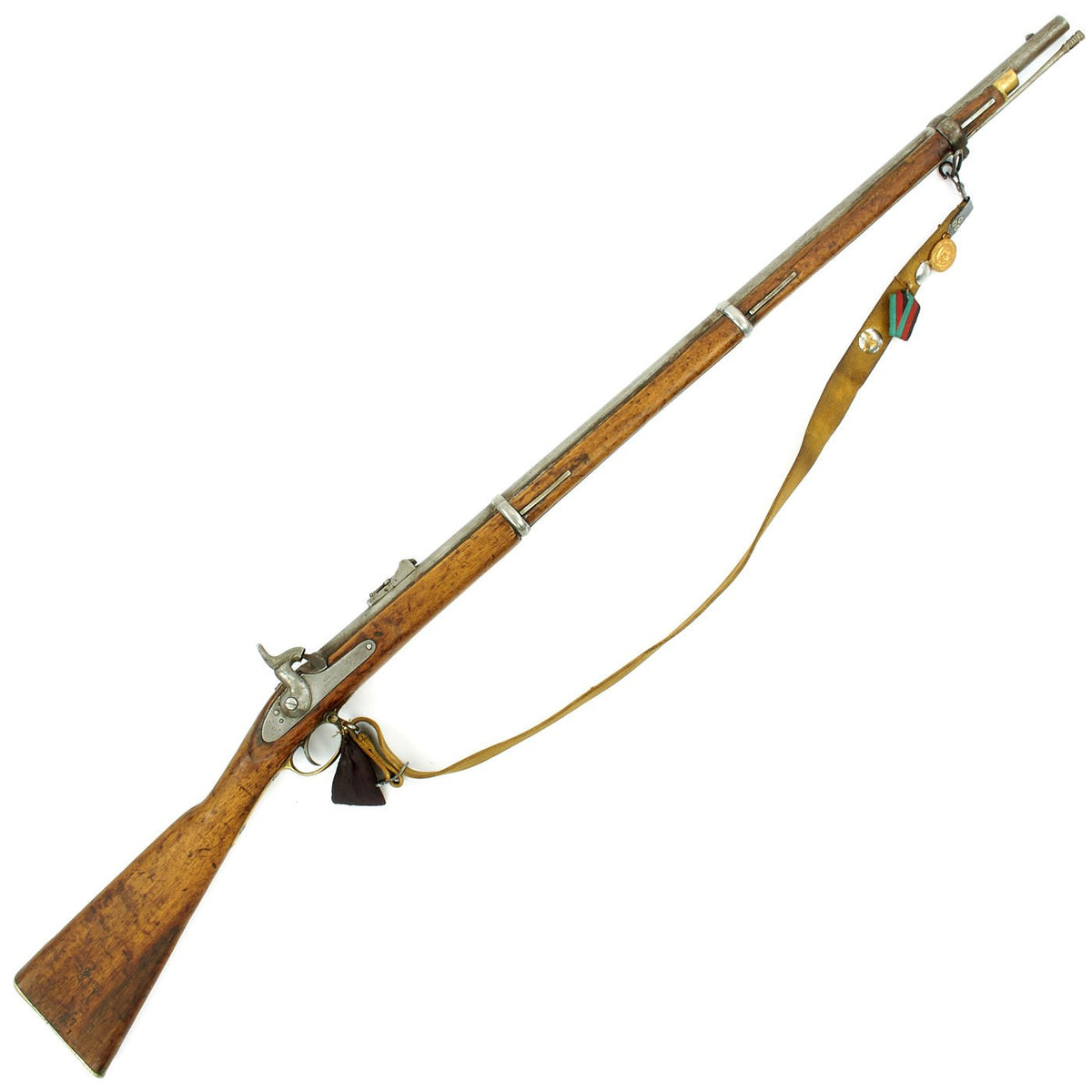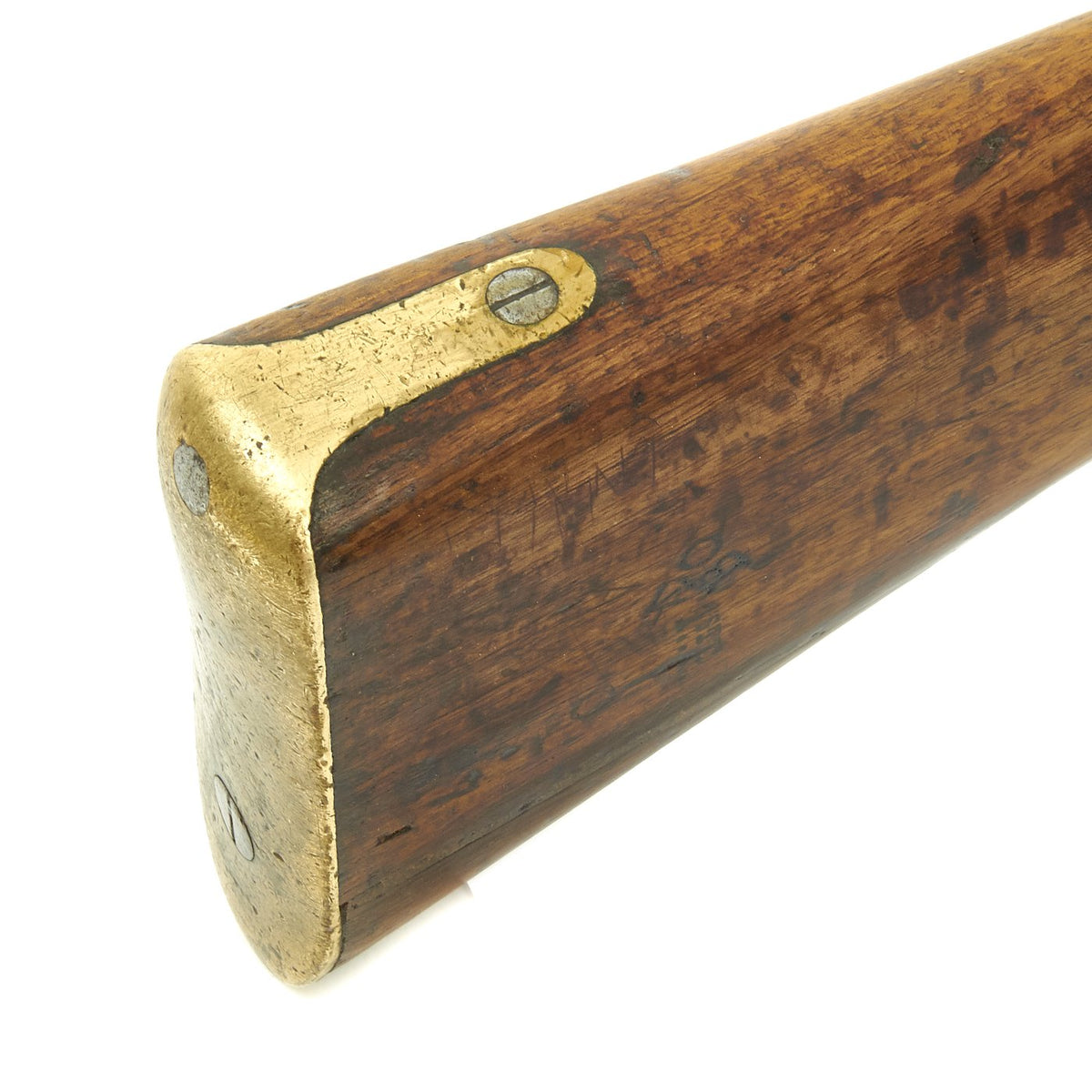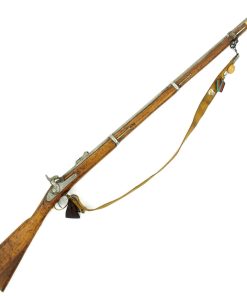Original British P-1853 Tower/V.R. Marked 2nd Model Enfield Rifle used in Russian Afghan Campaign – dated 1860 Original Items
$ 795,00 $ 238,50
Original item: One of a Kind. The Pattern 1853 Percussion ENFIELD rifle was the finest rifle of its day. It ended up all over the World. All over the British Empire and greatly imported into North America for use on both sides in the U.S. War between the States. Massive quantities were shipped into India, and it was due to the paper cartridges that were supplied with the muzzle loaders that triggered the 1857 Indian Mutiny or Sepoy Rebellion. The rumor had circulated that the paper cartridges, originally specified to use bee’s wax, were instead covered in both Cow’s Fat and Pig’s Fat, each of which were animals considered both sacred or untouchable to Hindu’s and Muslims respectfully.After the Rebellion had been quelled in 1858/9 it was decreed that SEPOY (Native) troops should not again be trusted with rifled weapons, so throughout India all such weapons were thereafter SMOOTH BORED. This order remained in effect until World War One.
Our P-1853, dated 1860, is a “Second Model”, indicated by the solid barrel band and band strings. It has also been smooth bored, indicating it was originally imported into India for issue to Native troops. However somewhere along the way it crossed the border into Afghanistan, from where it was recently discovered. It still retains all of its British Markings, though worn. The Lock is stamped with TOWER over 1860 as year of production, with a Crown over V.R. on the lock plate tail. This indicates that it was official issued to the British Military, and not a private purchase rifle.
The barrel still bears traces of the British Proof Marks it was first given as a .577 Caliber barrel. The Gun has retained all it’s British Military looks, other than no longer having a rifled barrel and was in Afghanistan for probably over 100 years. Now when found it sports a Soviet Canvas and Leather Military Sling fitted with a Russian Afghan Campaign medal, no doubt a casualty of some Afghan marksman who liberated the sling and attached it to his own weapon as a War Trophy.
The wood stock still retains B.O. and Broad Arrow stamp of THE BOARD OF ORDNANCE with all its finish having been painstakingly polished away, probably with handfuls of sand to polish the weapon.
So here is a BRITISH P-1853 PERCUSSION RIFLE made in 1860, shipped to INDIA and smooth bored for issue to Native/Sepoy troops that found it’s way into the hands of the Afghan Tribesmen who fought the Soviet army that invaded Afghanistan in 1979 and stayed for some 10 years and more recently used against U.S. and NATO forces in that troubled land.
The War Trophy of some returning G.I., Ready to Display with its very fascinating varied history!
More on the P-1853 Rifle-Musket: The Enfield Pattern 1853 rifle-musket (also known as the Pattern 1853 Enfield, P53 Enfield, and Enfield rifle-musket) was a .577 calibre Minié-type muzzle-loading rifle-musket, used by the British Empire from 1853 to 1867, after which many Enfield 1853 rifle-muskets were converted to (and replaced in service by) the cartridge-loaded Snider-Enfield rifle.
The term “rifle-musket” originally referred to muskets with the smooth-bored barrels replaced with rifled barrels. The length of the barrels were unchanged, allowing the weapons to be fired by rank, since a long rifle was necessary to enable the muzzles of the second rank of soldiers to project beyond the faces of the men in front. The weapon would also be sufficiently long when fitted with a bayonet to be effective against cavalry. Such guns manufactured with rifled barrels, muzzle loading, single shot, and utilizing the same firing mechanism, also came to be called rifle-muskets.
The 39 in (99 cm) barrel had three grooves, with a 1:78 rifling twist, and was fastened to the stock with three metal bands, so that the rifle was often called a “three band” model.
The rifle’s cartridges contained 68 grains (4.4 g) of black powder, and the ball was typically a 530-grain (34 g) Pritchett or a Burton-Minié, which would be driven out at about 850 to 900 feet (259 – 274m) per second. It was developed by William Pritchett in the 1850s.
The Enfield’s adjustable ladder rear sight had steps for 100 yards (91 m) – the default or “battle sight” range – 200 yards (180 m), 300 yards (270 m), and 400 yards (370 m). For distances beyond that, an adjustable flip-up blade sight was graduated (depending on the model and date of manufacture) from 900 yards (820 m) to 1,250 yards (1,140 m). British soldiers were trained to hit a target 6 feet (180 cm) by 2 feet (61 cm) – with a 2 feet (61 cm) diameter bull’s eye, counting 2 points – out to 600 yards (550 m). The target used from 650 yards (590 m) to 900 yards (820 m) had a 3 feet (91 cm) bull’s eye, with any man scoring 7 points with 20 rounds at that range being designated a marksman.
American Civil War
Confederates dead after the Second Battle of Fredericksburg on May 3, 1863. A number of Enfield 1853 rifled muskets can be seen where they have been dropped or fallen.
The Enfield 1853 rifle-musket was also used by both the North and the South in the American Civil War, and was the second most widely used infantry weapon in the war, surpassed only by the Springfield Model 1861 Rifled Musket. The Confederates imported more Enfields during the course of the war than any other small arm, buying from private contractors and gun runners. It has been estimated that over 900,000 P53 Enfields were imported to America and saw service in every major engagement from the Battle of Shiloh (April, 1862) and the Siege of Vicksburg (May 1863), to the final battles of 1865. The gun was highly sought after in the Confederate ranks. According to a survey taken by British officials during the early stages of war on the arms of the Western Confederate Forces, nearly 70% were armed with smoothbore arms, such as the Model 1842 Springfield, among others. Later in the war the same survey was taken, they found that more than 75% had attained a rifle and most being the Pattern 1853 Enfield.
Specifications:
Year of Manufacture: 1860
Caliber: .58 inches
Ammunition Type: Minie Ball and Powder Paper Cartridge
Barrel Length: 39 inches
Overall Length: 55 inches
Action: Side Action Lock
Feed System: Muzzle Loader
NOTE: International orders of antique firearms MUST be shipped using UPS WW Services (courier). USPS Priority Mail international will not accept these.
Fast Shipping with Professional Packaging
Thanks to our longstanding association with UPS FedEx DHL, and other major international carriers, we are able to provide a range of shipping options. Our warehouse staff is expertly trained and will wrap your products according to our exact and precise specifications. Prior to shipping, your goods will be thoroughly examined and securely secured. We ship to thousands clients each day across multiple countries. This shows how we're dedicated to be the largest retailer on the internet. Warehouses and distribution centres can be located throughout Europe as well as the USA.
Note: Orders with more than one item will be assigned a processing date depending on the item.
Before shipping before shipping, we'll conduct a thorough inspection of the items you have ordered. Today, the majority of orders will be delivered within 48 hours. The delivery time will be between 3-7 days.
Returns
The stock is dynamic and we cannot completely manage it because multiple stakeholders are involved, including our factory and warehouse. So the actual stock may alter at any time. It's possible that you may not receive your order once the order has been made.
Our policy is valid for a period of 30 days. If you don't receive the product within 30 days, we are not able to issue a refund or an exchange.
You can only return an item if it is unused and in the same state as the day you received it. You must have the item in its original packaging.
Related products
Uncategorized
Uncategorized
Uncategorized
Uncategorized
Uncategorized
Uncategorized
Uncategorized
Angolan Rebel 1970s era 60mm Inert Display Mortar from Angolan Civil War Original Items
Uncategorized
Uncategorized
Uncategorized
Armored Burgonet Helmet & Polearm from Scottish Castle Leith Hall Circa 1700 Original Items
Uncategorized
Uncategorized
Uncategorized
Uncategorized
Uncategorized
Uncategorized
Uncategorized













































































